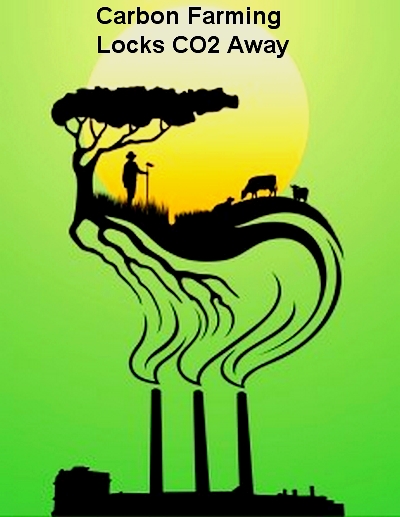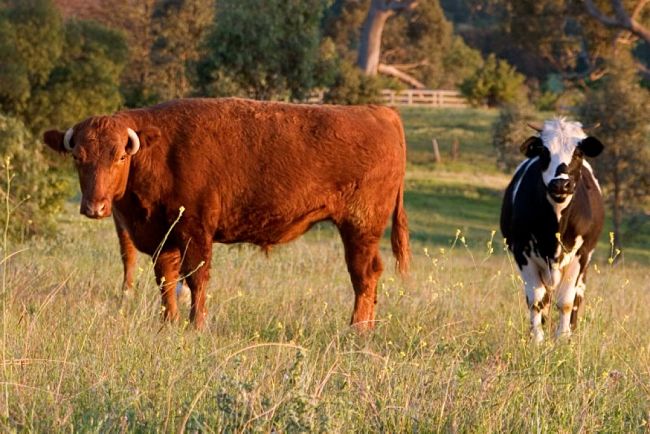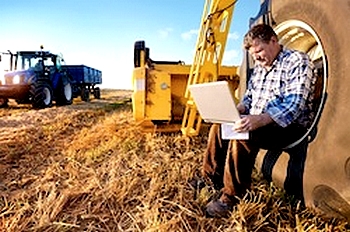Carbon Farming - Storing Carbon in Soils, Vegetation Offsets CO2 Emissions
Australia's Policy for a Clean Energy Future, that started with a Carbon Tax of $23 a tonne and transitions to an Emissions Trading Scheme after 3 years. The plan had four pillars:
- a carbon price;
- renewable energy;
- energy efficiency; and
- Carbon Farming (Land Use).
The plan also shows how the Australian Government was supporting Australian businesses, households, and communities to transition to a clean energy future. A carbon tax of $23 a tonne will be imposed on the 500 worst polluters with more than 50 percent of the funds being paid to the community to compensate for the increased cost of electricity and other costs. Fuel is exempt. The Australian Government has set targets of 5 percent below 2000 level by 2020 and 80 percent by 2050.



Carbon Farming
Australia aims to partially offset its emission by promoting schemed to increase the amount of carbon stored in vegetation and soils but has not set a target in terms of the increase amount of carbon it aims to store in this way. The current policy it based on delivering outputs and not on outcomes. It is akin to throwing money at the problem and hoping something will be achieved.
Existing Policy => Output based (The measure of success is spending the money)
Carbon can be removed from the atmosphere and stored in vegetation.
Conservation tillage practices seek to minimise soil disturbance and improve organic matter, as well as providing productivity benefits for farmers.
The Government wants to ensure that farmers and land managers who use their skills, experience and knowledge of the land to lower carbon pollution are rewarded for their efforts.
An ongoing Biodiversity Fund ($946 million over the first six years) will be established for projects to protect biodiverse carbon stores and secure environmental outcomes from carbon farming.
Carbon pollution on the land can be reduced by initiatives like capturing emissions from livestock manure or changing the way soil is tilled so that less carbon is released into the atmosphere.
The Government has decided to exclude the agricultural and land sectors from the carbon price.
Farmers, forestry operators and other land managers will not pay a price for the carbon pollution from their activities.
An ongoing Carbon Farming Futures program 4429 million over the first six years) will help farmers and landholders benefit from carbon farming by supporting research and development, measurement approaches and action on the ground to reduce emissions or store carbon, including support for conservation tillage equipment.
The Government will encourage and reward such action through its Carbon Farming Initiative.
- The Carbon Farming Initiative is a carbon offsets scheme that will provide new economic opportunities for farmers, forest growers and landholders and help the environment by reducing carbon pollution. Farmers and land managers will be able to generate credits that can then be sold to other businesses wanting to offset their own carbon pollution.
- The ongoing Carbon Fanning Initiative non-Kyoto Carbon Fund ($250 million over the first six years of the program) will increase incentives for activities that are not counted towards Australia'g emissions target under current international carbon accounting rules. These include soil carbon, revegetation and cessation of logging in native forests.
- Credits generated under the Carbon Farming Initiative that are recognised for Australia'g obligations under the Kyoto Protocol on climate change can be sold to companies with liabilities under the Carbon Pricing Mechanism. This includes credits earned from activities such as reforestation, savanna fire management and reductions in pollution from livestock and fertiliser.
What Australian Needs is a Soil Carbon Accounting System and an Outcome Based Policy
(What the Australian Government SHOULD do)
Proposed Strategy and Objective: To establish an Independent Carbon Farming Accounting and Management Authority and invest to increase the net amount of carbon sustainably stored in vegetation and soils on the continent of Australia to offset carbon emissions and help meet overall emission targets.
[Note this does not include subterranean carbon sequestration from burning coal etc.].
Proposed Outcome: To increase the net amount of carbon stored sustainably in vegetation and soils on the continent of Australia by 160 m tonnes per year by 2030 and 310 m tonnes by 2060 using investments from Australia and overseas. Note the amount are indicative but probably realistic.
As well an overall outcome Australia needs to establish outcomes for each of the components that can be used to store carbon, stop leakage and reduce emissions from livestock, farm practices, and land-fill waste. Note: Agricultural carbon is not included in the carbon tax and is unlikely to be included in the ETS for the time being.
|
Sub-Outcomes |
Percent |
|
Soil Carbon and Soil Management |
15 |
|
Forests |
25 |
|
Farm Management |
10 |
|
Revegetation |
25 |
|
Livestock and Farm animals |
5 |
|
Burning Regimes |
5 |
|
Reducing Leakage / Grave Yarding |
10 |
|
Urban Waste Management |
5 |
|
TOTAL |
100 |
|
Outcome 160 m tonnes per year stored by 2030, 310 m tonnes by 2060 (5% and 10%) |
Sub-Outcomes (What Should be Done)
Carbon Farming Accounting and Management Authority
Establishment of the Carbon Farming Accounting and Management Authority, that would monitor the net carbon account for vegetation and soils on the continent of Australia. This would be used to instantaneously track the amount of carbon stored. This authority would set the outcomes for the various components, invest in outputs and monitor the total carbon balance to ensure the annual targets are being met to achieve the outcomes. The authority would also manage the investments from the Australia Government and overseas sources and conduct audits to guarantee outcomes and manage credits. Payments would be made for each tonne of carbon which is stored or for the area of land set aside for sustainably storing carbon, or emission reduced through farming and land management. An ongoing Carbon Farming Futures R&D program will provide research and development. The feasibility of a farming carbon trading market would be examined using an auction or Ebay system where buyers could bid for carbon storage offers from private property owners and other land managers as part of an emissions trading scheme. Australia has the potential to attract huge investments from overseas polluters wanting to offset their carbon emissions.
Soil Carbon Storage and Soil Management
To increase the net amount of carbon stored in soils by 15% of the overall outcome.
Outputs
- Increase carbon storage in agricultural soils via management
- Reduced soil loss and erosion
- Soil conservation
- Payments to farmers for long term storage in soils
Forests
To increase the net amount of carbon stored in forests by 25% of the overall outcome
Outputs
- Reforestation
- Reduction in Deforestation
- Native Forest Protection and Management as Carbon Stores
- Grave Yarding of Carbon in Forest and timber products to allow harvesting without contributing to emissions.
- Changes in Forest Management for Managing Carbon Stored in Forests
Farm Management
To increase the net amount of carbon stored in vegetation and soils by changing farm management practices and increase storage by 10% of the overall outcome
Outputs
- Reduced pollution from burning of stubble and crop residue
- Reduced pollution from rice cultivation
- Reduced fertiliser pollution
- Manure management
Revegetation (Public, Indigenous and Private Land)
To increase the net amount of carbon stored through revegetation on private land by 15% of the overall outcome and public land by 10%.
Outputs
- Carbon storage Stewardship programs
- Payments to farmers to set aside part of their properties for revegetation and to manage the carbon stores
- Carbon Credits and Trading System
- Revegetation of public lands and management for carbon
Livestock and Farm animals
To decrease the amount of methane released by domestic animals by 5% of carbon equivalents of the overall outcome.
Outputs
- Reduced methane emissions from livestock digestion
- Control of pest animals
Burning Regimes
To decrease the amount of carbon released via burning regimes by 5% of the overall outcome.
Outputs
- Savanna fire management and other burning regimes
Reducing Leakage and Increase Carbon Grave Yarding
To decrease the amount of carbon released via leakage by 10% of the overall outcome. Increase the grave yarding of carbon.
Outputs
- Control leakage from the carbon stores through bush fires and composting of wood products
- Increase the grave yarding of carbon stored in timber and other sources.
- Phase out burning of wood for space heating
- Ensure that burning of biomass such as burning of trash for power generation has a net gain in terms of carbon storage and reduced emissions via offsets.
Urban Waste Management
To decrease the amount of methane released from urban landfill waste by 5% of the overall outcome.
Outputs
- Reduced pollution from legacy landfill waste.
Conclusion:
Australia needs a policy based a Carbon Accounting System and a set of OUTPUTS as goals for long-term NET storage of carbon in soils and vegetation.